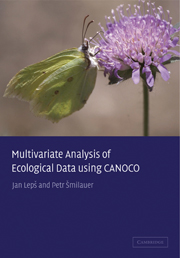Book contents
- Frontmatter
- Contents
- Preface
- 1 Introduction and data manipulation
- 2 Experimental design
- 3 Basics of gradient analysis
- 4 Using the Canoco for Windows 4.5 package
- 5 Constrained ordination and permutation tests
- 6 Similarity measures
- 7 Classification methods
- 8 Regression methods
- 9 Advanced use of ordination
- 10 Visualizing multivariate data
- 11 Case study 1: Variation in forest bird assemblages
- 12 Case study 2: Search for community composition patterns and their environmental correlates: vegetation of spring meadows
- 13 Case study 3: Separating the effects of explanatory variables
- 14 Case study 4: Evaluation of experiments in randomized complete blocks
- 15 Case study 5: Analysis of repeated observations of species composition from a factorial experiment
- 16 Case study 6: Hierarchical analysis of crayfish community variation
- 17 Case study 7: Differentiating two species and their hybrids with discriminant analysis
- Appendix A Sample datasets and projects
- Appendix B Vocabulary
- Appendix C Overview of available software
- References
- Index
12 - Case study 2: Search for community composition patterns and their environmental correlates: vegetation of spring meadows
Published online by Cambridge University Press: 09 February 2010
- Frontmatter
- Contents
- Preface
- 1 Introduction and data manipulation
- 2 Experimental design
- 3 Basics of gradient analysis
- 4 Using the Canoco for Windows 4.5 package
- 5 Constrained ordination and permutation tests
- 6 Similarity measures
- 7 Classification methods
- 8 Regression methods
- 9 Advanced use of ordination
- 10 Visualizing multivariate data
- 11 Case study 1: Variation in forest bird assemblages
- 12 Case study 2: Search for community composition patterns and their environmental correlates: vegetation of spring meadows
- 13 Case study 3: Separating the effects of explanatory variables
- 14 Case study 4: Evaluation of experiments in randomized complete blocks
- 15 Case study 5: Analysis of repeated observations of species composition from a factorial experiment
- 16 Case study 6: Hierarchical analysis of crayfish community variation
- 17 Case study 7: Differentiating two species and their hybrids with discriminant analysis
- Appendix A Sample datasets and projects
- Appendix B Vocabulary
- Appendix C Overview of available software
- References
- Index
Summary
In this case study, we will demonstrate a common application of multivariate analysis: the search for a pattern in a set of vegetation samples with available measurements of environmental variables. The species data comprise classical vegetation relevés (records of all vascular plants and bryophytes, with estimates of their abundance using the Braun–Blanquet scale) in spring fen meadows in the westernmost Carpathian mountain ranges. The data represent an ordinal transformation of the Braun–Blanquet scale, i.e. the r, +, and 1 to 5 values of the Braun–Blanquet scale are replaced by values 1 to 7. The relevés are complemented with environmental data – chemical analyses of the spring water, soil organic carbon content and slope of the locality. The ion concentrations represent their molarity: note that the environmental data are standardized in all CANOCO procedures and, consequently, the choice of units does not play any role (as long as the various units are linearly related).+ The data are courtesy of Michal Hájek and their analysis is presented in Hájek et al. (2002). The aim of this case study is to describe basic vegetation patterns and their relationship with available environmental data, mainly to the chemical properties of the spring water.
The data are stored in the file meadows.xls, where one sheet represents the species data, and the other one the environmental data (in comparison with the original, the data are slightly simplified). The data were imported to CANOCO format, using the WCanoImp program. Two files were created, meadows.spe and meadows.env. Note that in the Excel file, the species data are transposed (i.e. species as rows, samples as columns).
- Type
- Chapter
- Information
- Multivariate Analysis of Ecological Data using CANOCO , pp. 183 - 195Publisher: Cambridge University PressPrint publication year: 2003



